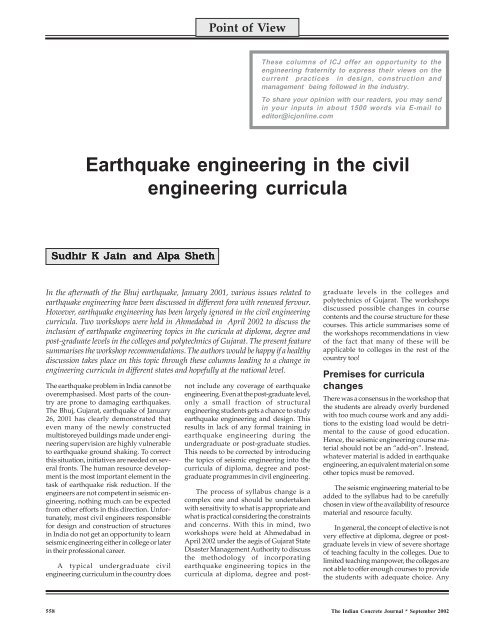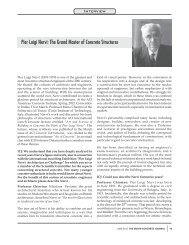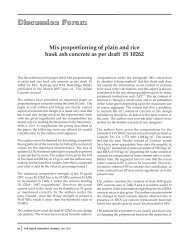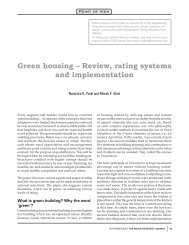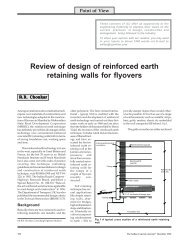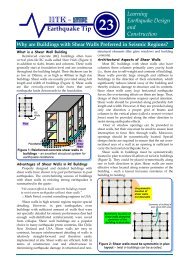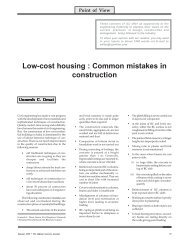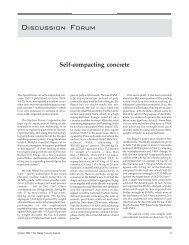Earthquake engineering in the civil engineering curricula
Earthquake engineering in the civil engineering curricula
Earthquake engineering in the civil engineering curricula
You also want an ePaper? Increase the reach of your titles
YUMPU automatically turns print PDFs into web optimized ePapers that Google loves.
The earthquake problem <strong>in</strong> India cannot be<br />
overemphasised. Most parts of <strong>the</strong> country<br />
are prone to damag<strong>in</strong>g earthquakes.<br />
The Bhuj, Gujarat, earthquake of January<br />
26, 2001 has clearly demonstrated that<br />
even many of <strong>the</strong> newly constructed<br />
multistoreyed build<strong>in</strong>gs made under <strong>eng<strong>in</strong>eer<strong>in</strong>g</strong><br />
supervision are highly vulnerable<br />
to earthquake ground shak<strong>in</strong>g. To correct<br />
this situation, <strong>in</strong>itiatives are needed on several<br />
fronts. The human resource development<br />
is <strong>the</strong> most important element <strong>in</strong> <strong>the</strong><br />
task of earthquake risk reduction. If <strong>the</strong><br />
eng<strong>in</strong>eers are not competent <strong>in</strong> seismic <strong>eng<strong>in</strong>eer<strong>in</strong>g</strong>,<br />
noth<strong>in</strong>g much can be expected<br />
from o<strong>the</strong>r efforts <strong>in</strong> this direction. Unfortunately,<br />
most <strong>civil</strong> eng<strong>in</strong>eers responsible<br />
for design and construction of structures<br />
<strong>in</strong> India do not get an opportunity to learn<br />
seismic <strong>eng<strong>in</strong>eer<strong>in</strong>g</strong> ei<strong>the</strong>r <strong>in</strong> college or later<br />
<strong>in</strong> <strong>the</strong>ir professional career.<br />
A typical undergraduate <strong>civil</strong><br />
<strong>eng<strong>in</strong>eer<strong>in</strong>g</strong> curriculum <strong>in</strong> <strong>the</strong> country does<br />
Po<strong>in</strong>t of View<br />
In <strong>the</strong> aftermath of <strong>the</strong> Bhuj earthquake, January 2001, various issues related to<br />
earthquake <strong>eng<strong>in</strong>eer<strong>in</strong>g</strong> have been discussed <strong>in</strong> different fora with renewed fervour.<br />
However, earthquake <strong>eng<strong>in</strong>eer<strong>in</strong>g</strong> has been largely ignored <strong>in</strong> <strong>the</strong> <strong>civil</strong> <strong>eng<strong>in</strong>eer<strong>in</strong>g</strong><br />
<strong>curricula</strong>. Two workshops were held <strong>in</strong> Ahmedabad <strong>in</strong> April 2002 to discuss <strong>the</strong><br />
<strong>in</strong>clusion of earthquake <strong>eng<strong>in</strong>eer<strong>in</strong>g</strong> topics <strong>in</strong> <strong>the</strong> curicula at diploma, degree and<br />
post-graduate levels <strong>in</strong> <strong>the</strong> colleges and polytechnics of Gujarat. The present feature<br />
summarises <strong>the</strong> workshop recommendations. The authors would be happy if a healthy<br />
discussion takes place on this topic through <strong>the</strong>se columns lead<strong>in</strong>g to a change <strong>in</strong><br />
<strong>eng<strong>in</strong>eer<strong>in</strong>g</strong> <strong>curricula</strong> <strong>in</strong> different states and hopefully at <strong>the</strong> national level.<br />
not <strong>in</strong>clude any coverage of earthquake<br />
<strong>eng<strong>in</strong>eer<strong>in</strong>g</strong>. Even at <strong>the</strong> post-graduate level,<br />
only a small fraction of structural<br />
<strong>eng<strong>in</strong>eer<strong>in</strong>g</strong> students gets a chance to study<br />
earthquake <strong>eng<strong>in</strong>eer<strong>in</strong>g</strong> and design. This<br />
results <strong>in</strong> lack of any formal tra<strong>in</strong><strong>in</strong>g <strong>in</strong><br />
earthquake <strong>eng<strong>in</strong>eer<strong>in</strong>g</strong> dur<strong>in</strong>g <strong>the</strong><br />
undergraduate or post-graduate studies.<br />
This needs to be corrected by <strong>in</strong>troduc<strong>in</strong>g<br />
<strong>the</strong> topics of seismic <strong>eng<strong>in</strong>eer<strong>in</strong>g</strong> <strong>in</strong>to <strong>the</strong><br />
<strong>curricula</strong> of diploma, degree and postgraduate<br />
programmes <strong>in</strong> <strong>civil</strong> <strong>eng<strong>in</strong>eer<strong>in</strong>g</strong>.<br />
The process of syllabus change is a<br />
complex one and should be undertaken<br />
with sensitivity to what is appropriate and<br />
what is practical consider<strong>in</strong>g <strong>the</strong> constra<strong>in</strong>ts<br />
and concerns. With this <strong>in</strong> m<strong>in</strong>d, two<br />
workshops were held at Ahmedabad <strong>in</strong><br />
April 2002 under <strong>the</strong> aegis of Gujarat State<br />
Disaster Management Authority to discuss<br />
<strong>the</strong> methodology of <strong>in</strong>corporat<strong>in</strong>g<br />
earthquake <strong>eng<strong>in</strong>eer<strong>in</strong>g</strong> topics <strong>in</strong> <strong>the</strong><br />
<strong>curricula</strong> at diploma, degree and post-<br />
These columns of ICJ offer an opportunity to <strong>the</strong><br />
<strong>eng<strong>in</strong>eer<strong>in</strong>g</strong> fraternity to express <strong>the</strong>ir views on <strong>the</strong><br />
current practices <strong>in</strong> design, construction and<br />
management be<strong>in</strong>g followed <strong>in</strong> <strong>the</strong> <strong>in</strong>dustry.<br />
To share your op<strong>in</strong>ion with our readers, you may send<br />
<strong>in</strong> your <strong>in</strong>puts <strong>in</strong> about 1500 words via E-mail to<br />
editor@icjonl<strong>in</strong>e.com<br />
<strong>Earthquake</strong> <strong>eng<strong>in</strong>eer<strong>in</strong>g</strong> <strong>in</strong> <strong>the</strong> <strong>civil</strong><br />
<strong>eng<strong>in</strong>eer<strong>in</strong>g</strong> <strong>curricula</strong><br />
Sudhir Sudhir K K K Ja<strong>in</strong> Ja<strong>in</strong> and and and Alpa Alpa Alpa Sheth<br />
Sheth<br />
graduate levels <strong>in</strong> <strong>the</strong> colleges and<br />
polytechnics of Gujarat. The workshops<br />
discussed possible changes <strong>in</strong> course<br />
contents and <strong>the</strong> course structure for <strong>the</strong>se<br />
courses. This article summarises some of<br />
<strong>the</strong> workshops recommendations <strong>in</strong> view<br />
of <strong>the</strong> fact that many of <strong>the</strong>se will be<br />
applicable to colleges <strong>in</strong> <strong>the</strong> rest of <strong>the</strong><br />
country too!<br />
Premises for <strong>curricula</strong><br />
changes<br />
There was a consensus <strong>in</strong> <strong>the</strong> workshop that<br />
<strong>the</strong> students are already overly burdened<br />
with too much course work and any additions<br />
to <strong>the</strong> exist<strong>in</strong>g load would be detrimental<br />
to <strong>the</strong> cause of good education.<br />
Hence, <strong>the</strong> seismic <strong>eng<strong>in</strong>eer<strong>in</strong>g</strong> course material<br />
should not be an “add-on”. Instead,<br />
whatever material is added <strong>in</strong> earthquake<br />
<strong>eng<strong>in</strong>eer<strong>in</strong>g</strong>, an equivalent material on some<br />
o<strong>the</strong>r topics must be removed.<br />
The seismic <strong>eng<strong>in</strong>eer<strong>in</strong>g</strong> material to be<br />
added to <strong>the</strong> syllabus had to be carefully<br />
chosen <strong>in</strong> view of <strong>the</strong> availability of resource<br />
material and resource faculty.<br />
In general, <strong>the</strong> concept of elective is not<br />
very effective at diploma, degree or postgraduate<br />
levels <strong>in</strong> view of severe shortage<br />
of teach<strong>in</strong>g faculty <strong>in</strong> <strong>the</strong> colleges. Due to<br />
limited teach<strong>in</strong>g manpower, <strong>the</strong> colleges are<br />
not able to offer enough courses to provide<br />
<strong>the</strong> students with adequate choice. Any<br />
558 The Indian Concrete Journal * September 2002
changes <strong>in</strong> syllabus should bear this <strong>in</strong> m<strong>in</strong>d,<br />
that, if <strong>the</strong> topics of earthquake <strong>eng<strong>in</strong>eer<strong>in</strong>g</strong><br />
are <strong>in</strong>troduced as elective courses, chances<br />
are that such a course may not be offered.<br />
The degree and post-graduate<br />
programmes of <strong>the</strong> <strong>eng<strong>in</strong>eer<strong>in</strong>g</strong> colleges<br />
come under <strong>the</strong> purview of <strong>the</strong> respective<br />
universities. As a result, <strong>the</strong>re are as many<br />
different <strong>curricula</strong> as <strong>the</strong> number of<br />
universities <strong>in</strong>volved. The changes <strong>in</strong><br />
<strong>curricula</strong> have to go through <strong>the</strong> usual<br />
processes of <strong>the</strong> respective universities. On<br />
<strong>the</strong> o<strong>the</strong>r hand, <strong>the</strong> polytechnic system <strong>in</strong><br />
Gujarat has a special Curriculum<br />
Development Cell (CDC) meant to review<br />
and revise <strong>the</strong> curriculum based on <strong>the</strong><br />
<strong>in</strong>dustry requirements as well <strong>the</strong> chang<strong>in</strong>g<br />
technologies from time to time. As<br />
compared to <strong>the</strong> degree programme, it is<br />
relatively easier to make changes to <strong>the</strong><br />
diploma programme. The polytechnics are<br />
directly governed by <strong>the</strong> state governments<br />
and do not come under <strong>the</strong> university<br />
system. As a result, all polytechnics of <strong>the</strong><br />
state follow <strong>the</strong> same <strong>curricula</strong>.<br />
Diploma programme<br />
Exist<strong>in</strong>g curriculum<br />
As per <strong>the</strong> present curriculum of diploma<br />
<strong>in</strong> <strong>civil</strong> <strong>eng<strong>in</strong>eer<strong>in</strong>g</strong> followed <strong>in</strong> <strong>the</strong> polytechnics<br />
of Gujarat, a student takes a total of<br />
37 courses <strong>in</strong> <strong>the</strong> three year (six semesters)<br />
diploma course. Thus <strong>in</strong> each semester, he<br />
takes about six courses. The courses are<br />
divided <strong>in</strong>to <strong>the</strong> follow<strong>in</strong>g.<br />
Foundation and Hard Core courses which<br />
are common to all branches of <strong>eng<strong>in</strong>eer<strong>in</strong>g</strong><br />
and <strong>in</strong>clude fundamental ma<strong>the</strong>matics and<br />
science courses, communication skills, <strong>eng<strong>in</strong>eer<strong>in</strong>g</strong><br />
draw<strong>in</strong>g, workshop, <strong>eng<strong>in</strong>eer<strong>in</strong>g</strong><br />
mechanics, computers, environment, human<br />
resources, <strong>eng<strong>in</strong>eer<strong>in</strong>g</strong> elements and<br />
so on.<br />
Soft Core Courses such as market<strong>in</strong>g, advanced<br />
ma<strong>the</strong>matics, advanced applied<br />
science and o<strong>the</strong>rs.<br />
Basic Technology Courses specifically for<br />
<strong>the</strong> <strong>civil</strong> <strong>eng<strong>in</strong>eer<strong>in</strong>g</strong> students which <strong>in</strong>clude<br />
<strong>eng<strong>in</strong>eer<strong>in</strong>g</strong> draw<strong>in</strong>g, mechanics of structures<br />
I and II, hydraulics, material technology,<br />
survey<strong>in</strong>g I and II and soil <strong>eng<strong>in</strong>eer<strong>in</strong>g</strong>.<br />
Applied Technology Courses which are<br />
advanced courses and <strong>in</strong>clude structural<br />
design and draw<strong>in</strong>g <strong>in</strong> RC and steel, quantity<br />
survey<strong>in</strong>g, professional practice, transportation,<br />
irrigation, public health, construction<br />
technology, and project.<br />
Po<strong>in</strong>t of View<br />
Diversified Elective Courses <strong>in</strong> which a<br />
student may choose electives from water<br />
resources, advanced construction technology,<br />
construction works management, concrete<br />
technology, computer aided structural<br />
analysis and design, quality control and<br />
ma<strong>in</strong>tenance, computer based technology,<br />
<strong>in</strong>dustrial waster water management and<br />
architectural render<strong>in</strong>g.<br />
After <strong>the</strong> earthquake of January 26,<br />
2001, some coverage of earthquake<br />
<strong>eng<strong>in</strong>eer<strong>in</strong>g</strong> was <strong>in</strong>troduced <strong>in</strong> <strong>the</strong> diploma<br />
curriculum. It consisted of 5 lecture hours<br />
and 2 practical hours with<strong>in</strong> <strong>the</strong> elective<br />
course of Advanced Construction Technology.<br />
These contents were reviewed dur<strong>in</strong>g <strong>the</strong><br />
workshop and <strong>the</strong> general consensus was<br />
that:<br />
• <strong>the</strong>se contents are too exhaustive<br />
to be covered <strong>in</strong> five lecture hours<br />
• many of <strong>the</strong> topics were too advanced<br />
for diploma level.<br />
Each semester is 18 weeks long and<br />
consists of 14 weeks of teach<strong>in</strong>g. The scope<br />
of <strong>the</strong> syllabus is quite wide and it is often<br />
not feasible to complete it satisfactorily<br />
with<strong>in</strong> <strong>the</strong> semester time frame.<br />
Introduction of seismic<br />
<strong>eng<strong>in</strong>eer<strong>in</strong>g</strong> <strong>in</strong> <strong>the</strong> curriculum<br />
For <strong>in</strong>troduction of earthquake <strong>eng<strong>in</strong>eer<strong>in</strong>g</strong><br />
contents, two options were debated:<br />
(i) hav<strong>in</strong>g a separate course on earthquake<br />
<strong>eng<strong>in</strong>eer<strong>in</strong>g</strong> cover<strong>in</strong>g whatever contents<br />
are considered necessary to be <strong>in</strong>cluded,<br />
and<br />
(ii) <strong>in</strong>troduc<strong>in</strong>g <strong>the</strong> earthquake <strong>eng<strong>in</strong>eer<strong>in</strong>g</strong><br />
contents <strong>in</strong>to different exist<strong>in</strong>g<br />
courses.<br />
Both <strong>the</strong> options have advantages and<br />
disadvantages. After considerable<br />
discussion, it was decided to opt for <strong>the</strong><br />
second model for <strong>the</strong> polytechnics of<br />
Gujarat. In <strong>the</strong> first model <strong>in</strong>volv<strong>in</strong>g an<br />
addition of a new course, one of <strong>the</strong> exist<strong>in</strong>g<br />
courses will have to be removed from <strong>the</strong><br />
curriculum and a review of <strong>the</strong> course<br />
structure did not show a clear choice of <strong>the</strong><br />
course to be deleted. Moreover, <strong>the</strong><br />
concerned exist<strong>in</strong>g courses were found to<br />
have adequate scope for <strong>in</strong>troduction of<br />
relevant coverage of earthquake <strong>eng<strong>in</strong>eer<strong>in</strong>g</strong><br />
topics.<br />
It was recommended that <strong>the</strong> diploma<br />
programme should conta<strong>in</strong> four modules<br />
on earthquake <strong>eng<strong>in</strong>eer<strong>in</strong>g</strong> to be <strong>in</strong>troduced<br />
at different levels.<br />
Module I: Introduction to<br />
earthquakes and cyclones<br />
This is <strong>the</strong> basic module <strong>in</strong>troduc<strong>in</strong>g <strong>the</strong><br />
students to earthquakes and cyclones. This<br />
module would <strong>in</strong>clude <strong>the</strong> follow<strong>in</strong>g topics,<br />
and it can be covered adequately <strong>in</strong> 11<br />
lecture hours.<br />
n Introduction to earthquakes: causes of<br />
earthquakes, basic term<strong>in</strong>ology, magnitude<br />
and <strong>in</strong>tensity, earthquake effects, past<br />
earthquakes and lessons learnt.<br />
n Introduction to cyclones: characteristics<br />
of cyclones, cyclone effects, past cyclones<br />
<strong>in</strong> <strong>the</strong> region.<br />
It is proposed that <strong>the</strong>se fundamentals<br />
should be taught to diploma students of<br />
“all <strong>eng<strong>in</strong>eer<strong>in</strong>g</strong> branches”. Hence, this may<br />
be <strong>in</strong>troduced <strong>in</strong> <strong>the</strong> hard core course<br />
(compulsory to all branches) on “Essentials<br />
of Environment” by replac<strong>in</strong>g topics of<br />
“Environmental Legislation” and<br />
“Environmental Impact Assessment”.<br />
Module 2: Seismic detail<strong>in</strong>g of RC<br />
structures<br />
There was a consensus that <strong>the</strong> eng<strong>in</strong>eer at<br />
site would be sensitive to <strong>the</strong> ductile detail<strong>in</strong>g<br />
practices required <strong>in</strong> seismic <strong>eng<strong>in</strong>eer<strong>in</strong>g</strong><br />
if he had been exposed to it at college<br />
level and understands <strong>the</strong> objectives and<br />
advantages of seismic detail<strong>in</strong>g. Hence, <strong>the</strong><br />
<strong>civil</strong> <strong>eng<strong>in</strong>eer<strong>in</strong>g</strong> diploma students should<br />
be exposed to <strong>the</strong> codal provisions on ductile<br />
detail<strong>in</strong>g of RC build<strong>in</strong>gs<br />
(IS 13920 : 1993). The estimated hours required<br />
to cover this code satisfactorily are<br />
estimated to be about 8 hours. An obvious<br />
choice for <strong>in</strong>troduc<strong>in</strong>g this module is <strong>the</strong><br />
RC design course which <strong>in</strong> <strong>the</strong> present case<br />
had obvious scope for add<strong>in</strong>g <strong>the</strong>se lectures.<br />
Module 3: Seismic resistance for<br />
masonry houses<br />
A large part of <strong>the</strong> people <strong>in</strong> Gujarat and <strong>in</strong><br />
rest of <strong>the</strong> country live <strong>in</strong> masonry homes<br />
and it is very important to teach <strong>the</strong> fundamentals<br />
of earthquake resistant masonry<br />
structures. In this module, <strong>the</strong> students<br />
shall be <strong>in</strong>troduced to detail<strong>in</strong>g of masonry<br />
houses for seismic resistance such as provision<br />
of l<strong>in</strong>tel, pl<strong>in</strong>th and roof bands, roof<br />
diaphragm action, and provisions of<br />
IS 4326 on masonry build<strong>in</strong>gs. About six<br />
hours shall be needed to cover <strong>the</strong>se topics.<br />
This module is proposed to be <strong>in</strong>troduced<br />
<strong>in</strong> “Construction Technology” course by<br />
condens<strong>in</strong>g <strong>the</strong> exist<strong>in</strong>g topics.<br />
Module 4: <strong>Earthquake</strong> effects on soils<br />
It is proposed that <strong>in</strong> <strong>the</strong> course of “Soil<br />
September 2002 * The Indian Concrete Journal 559
Eng<strong>in</strong>eer<strong>in</strong>g”, about two lecture hours<br />
be spent by <strong>the</strong> <strong>in</strong>structors expla<strong>in</strong><strong>in</strong>g<br />
<strong>the</strong> phenomenon of liquefaction and<br />
possible remedial measures.<br />
It is also recommended that after<br />
sufficient expertise <strong>in</strong> earthquake<br />
<strong>eng<strong>in</strong>eer<strong>in</strong>g</strong> is ga<strong>in</strong>ed by adequate number<br />
of teachers <strong>in</strong> <strong>the</strong> polytechnics of Gujarat, a<br />
new elective course be developed under <strong>the</strong><br />
category “Diversified Elective Courses”.<br />
Degree programme<br />
Exist<strong>in</strong>g curriculum<br />
The structure of present degree curriculum<br />
differs <strong>in</strong> different universities. However,<br />
some general trends are obvious. For example,<br />
most universities <strong>in</strong> Gujarat have<br />
separate departments for <strong>civil</strong> <strong>eng<strong>in</strong>eer<strong>in</strong>g</strong><br />
and applied mechanics. The structural <strong>eng<strong>in</strong>eer<strong>in</strong>g</strong><br />
courses are usually covered by<br />
<strong>the</strong> departments of applied mechanics.<br />
Hence, any proposals for syllabus change<br />
must respond to this. For <strong>in</strong>stance, it will<br />
be cumbersome if <strong>the</strong> proposed changes<br />
require that a course <strong>in</strong> earthquake <strong>eng<strong>in</strong>eer<strong>in</strong>g</strong><br />
(to be taught by <strong>the</strong> department of<br />
applied mechanics) be <strong>in</strong>cluded by dropp<strong>in</strong>g<br />
a course from amongst those taught<br />
by <strong>the</strong> department of <strong>civil</strong> <strong>eng<strong>in</strong>eer<strong>in</strong>g</strong>.<br />
Almost all colleges <strong>in</strong> Gujarat have three<br />
to four compulsory courses <strong>in</strong> structural<br />
analysis and two to three courses <strong>in</strong><br />
structural design. Thus, most universities<br />
have five to seven courses <strong>in</strong> structural<br />
analysis and design.<br />
Even though <strong>the</strong> present syllabus is<br />
different <strong>in</strong> <strong>the</strong> colleges, almost none of <strong>the</strong><br />
Gujarat colleges currently teach <strong>the</strong><br />
fundamentals of seismic <strong>eng<strong>in</strong>eer<strong>in</strong>g</strong> at <strong>the</strong><br />
degree level.<br />
As all <strong>the</strong> universities have a different<br />
syllabus and course format, <strong>the</strong> workshop<br />
objective was not to review <strong>the</strong> syllabus of<br />
each university <strong>in</strong> detail and offer tailormade<br />
modifications for each university.<br />
Instead, an effort was made to develop a<br />
broad outl<strong>in</strong>e that can be considered by <strong>the</strong><br />
different universities for undertak<strong>in</strong>g<br />
changes <strong>in</strong> <strong>the</strong>ir <strong>curricula</strong>.<br />
Introduction of seismic<br />
<strong>eng<strong>in</strong>eer<strong>in</strong>g</strong> <strong>in</strong> <strong>the</strong> curriculum<br />
Two models are possible for <strong>in</strong>corporat<strong>in</strong>g<br />
earthquake <strong>eng<strong>in</strong>eer<strong>in</strong>g</strong> <strong>in</strong> <strong>the</strong> curriculum<br />
at degree level:<br />
Model 1: In this model, a separate course<br />
<strong>in</strong> earthquake <strong>eng<strong>in</strong>eer<strong>in</strong>g</strong> can be <strong>in</strong>troduced<br />
conta<strong>in</strong><strong>in</strong>g what all a degree student should<br />
learn <strong>in</strong> earthquake <strong>eng<strong>in</strong>eer<strong>in</strong>g</strong>. However,<br />
Po<strong>in</strong>t of View<br />
this will require that one of <strong>the</strong> exist<strong>in</strong>g<br />
courses be removed from <strong>the</strong> curriculum.<br />
Model 2: In this model, <strong>the</strong> seismic<br />
<strong>eng<strong>in</strong>eer<strong>in</strong>g</strong> issues can be <strong>in</strong>corporated <strong>in</strong><br />
<strong>the</strong> exist<strong>in</strong>g courses. Thus, <strong>the</strong> seismic<br />
<strong>eng<strong>in</strong>eer<strong>in</strong>g</strong> contents will be distributed <strong>in</strong>to<br />
a number of exist<strong>in</strong>g courses. It will require<br />
rationalis<strong>in</strong>g some of <strong>the</strong> exist<strong>in</strong>g courses<br />
by remov<strong>in</strong>g topics, considered not so<br />
important, to make space for <strong>the</strong> new topics.<br />
Considerable discussion took place<br />
between <strong>the</strong> Models 1 and 2 above. Both<br />
<strong>the</strong> models have advantages and<br />
disadvantages. It was felt that <strong>in</strong> <strong>the</strong> long<br />
run, Model 2 would be better s<strong>in</strong>ce it would<br />
enable better <strong>in</strong>tegration of earthquake<br />
<strong>eng<strong>in</strong>eer<strong>in</strong>g</strong> <strong>in</strong>to <strong>the</strong> <strong>civil</strong> <strong>eng<strong>in</strong>eer<strong>in</strong>g</strong><br />
education, and would help remove <strong>the</strong> myth<br />
that earthquake <strong>eng<strong>in</strong>eer<strong>in</strong>g</strong> is a<br />
superspecialty which need not be known to<br />
<strong>civil</strong> eng<strong>in</strong>eers. However, from <strong>the</strong> view po<strong>in</strong>t<br />
of implementation <strong>in</strong> <strong>the</strong> short term, several<br />
advantages were obvious <strong>in</strong> Model 1:<br />
• As of now, most teachers <strong>in</strong> <strong>the</strong> <strong>eng<strong>in</strong>eer<strong>in</strong>g</strong><br />
<strong>in</strong>stitutions are <strong>the</strong>mselves<br />
not proficient <strong>in</strong> seismic <strong>eng<strong>in</strong>eer<strong>in</strong>g</strong>.<br />
In Model 1, <strong>the</strong> college<br />
will need only one teacher at one<br />
time to be teach<strong>in</strong>g seismic <strong>eng<strong>in</strong>eer<strong>in</strong>g</strong>.<br />
With careful choice of <strong>the</strong> concerned<br />
teacher, and with an additional<br />
effort on <strong>the</strong> part of that<br />
teacher, it may be possible to do<br />
justice with that course. In case of<br />
Model 2, it will be much harder to<br />
ensure that several teachers <strong>in</strong>volved<br />
<strong>in</strong> teach<strong>in</strong>g seismic <strong>eng<strong>in</strong>eer<strong>in</strong>g</strong><br />
<strong>in</strong> several courses will be able to<br />
do similar justice.<br />
• Most text-books used <strong>in</strong> <strong>the</strong> colleges<br />
do not yet cover <strong>the</strong> topics of earthquake<br />
<strong>eng<strong>in</strong>eer<strong>in</strong>g</strong>. This will aga<strong>in</strong><br />
be a handicap <strong>in</strong> <strong>the</strong> implementation<br />
of Model 2.<br />
• A good feedback mechanism can<br />
be developed <strong>in</strong> <strong>the</strong> <strong>in</strong>itial years on<br />
<strong>the</strong> appropriate level and contents<br />
of earthquake <strong>eng<strong>in</strong>eer<strong>in</strong>g</strong> topics if<br />
<strong>the</strong> entire th<strong>in</strong>g is done <strong>in</strong> one course,<br />
ra<strong>the</strong>r than spread out <strong>in</strong> several<br />
courses.<br />
• Introduction of a separate and compulsory<br />
course <strong>in</strong> earthquake <strong>eng<strong>in</strong>eer<strong>in</strong>g</strong><br />
at this stage <strong>in</strong> <strong>the</strong> colleges<br />
will give a strong signal to students,<br />
teachers, and <strong>the</strong> college adm<strong>in</strong>istrators<br />
for <strong>the</strong> need to develop<br />
earthquake <strong>eng<strong>in</strong>eer<strong>in</strong>g</strong> expertise <strong>in</strong><br />
<strong>the</strong> technical education system.<br />
This could be very helpful towards<br />
capacity build<strong>in</strong>g <strong>in</strong> earthquake <strong>eng<strong>in</strong>eer<strong>in</strong>g</strong>.<br />
Most of <strong>the</strong> participants <strong>in</strong> <strong>the</strong><br />
Ahmedabad workshop were of <strong>the</strong> op<strong>in</strong>ion<br />
that at this po<strong>in</strong>t of time, it is best to<br />
<strong>in</strong>troduce Model 1. After ga<strong>in</strong><strong>in</strong>g enough<br />
experience and after a larger number of<br />
teachers have acquired expertise <strong>in</strong><br />
earthquake <strong>eng<strong>in</strong>eer<strong>in</strong>g</strong>, <strong>the</strong> universities may<br />
consider mov<strong>in</strong>g <strong>in</strong>to Model 2.<br />
The workshop participants agreed that<br />
<strong>the</strong> coverage of structural <strong>eng<strong>in</strong>eer<strong>in</strong>g</strong><br />
courses <strong>in</strong> <strong>the</strong> degree programme is fairly<br />
large and that this can be consolidated to<br />
reduce one course to create place for a course<br />
on earthquake <strong>eng<strong>in</strong>eer<strong>in</strong>g</strong>. There was<br />
consensus that with recent developments<br />
<strong>in</strong> <strong>the</strong> field of computer aided structural<br />
analysis, many traditional analysis<br />
methods can be elim<strong>in</strong>ated from <strong>the</strong><br />
curriculum.<br />
Table 1 gives <strong>the</strong> proposed contents of<br />
<strong>the</strong> new course for earthquake <strong>eng<strong>in</strong>eer<strong>in</strong>g</strong>.<br />
It may be emphasised here that this is only<br />
Table 1: Proposed compulsory course on earthquake <strong>eng<strong>in</strong>eer<strong>in</strong>g</strong> <strong>in</strong> <strong>the</strong> B.E. <strong>civil</strong><br />
<strong>eng<strong>in</strong>eer<strong>in</strong>g</strong> curriculum<br />
Topic Lecture hours<br />
Introduction to earthquakes (causes of earthquakes, basic term<strong>in</strong>ology, magnitude, <strong>in</strong>tensity,<br />
peak ground motion parameters)<br />
5<br />
Past earthquakes and lessons learnt 3<br />
Introduction to <strong>the</strong>ory of vibrations, concept of response spectrum. 8<br />
Lateral force analysis of build<strong>in</strong>gs, floor diaphragm action, moment resist<strong>in</strong>g frames, shear walls. 6<br />
Concepts of seismic design, lateral strength, stiffness, ductility, and structural configuration.<br />
Design spectrum. Base isolation.<br />
4<br />
Provisions of IS:1893 for build<strong>in</strong>gs 4<br />
Seismic design of masonry structures, provisions of IS:4326. 4<br />
Seismic design and detail<strong>in</strong>g of rc build<strong>in</strong>gs, provisions of IS:13920 6<br />
Soil response to earthquakes, liquefaction and remedial measures. 2<br />
560 The Indian Concrete Journal * September 2002
a suggested outl<strong>in</strong>e, and that <strong>in</strong>dividual<br />
universities should strive to adapt this to<br />
suit <strong>the</strong>ir own <strong>curricula</strong> and faculty<br />
strengths. This course may be considered<br />
for <strong>in</strong>clusion towards <strong>the</strong> end of <strong>the</strong> degree<br />
programme after <strong>the</strong> student has an<br />
adequate grasp of basic analysis and design<br />
concepts.<br />
Seismic <strong>eng<strong>in</strong>eer<strong>in</strong>g</strong> <strong>in</strong> <strong>the</strong><br />
post-graduate programme<br />
At post-graduate level, <strong>the</strong> status of earthquake<br />
<strong>eng<strong>in</strong>eer<strong>in</strong>g</strong> education is not very different.<br />
Most of <strong>the</strong> Masters’ programmes <strong>in</strong><br />
structural <strong>eng<strong>in</strong>eer<strong>in</strong>g</strong> do have some coverage<br />
of structural dynamics but hardly any<br />
coverage for earthquake <strong>eng<strong>in</strong>eer<strong>in</strong>g</strong>. This<br />
needs to be corrected so that every postgraduate<br />
<strong>in</strong> structural <strong>eng<strong>in</strong>eer<strong>in</strong>g</strong> is adequately<br />
prepared to analyse and design<br />
build<strong>in</strong>gs and o<strong>the</strong>r common structures for<br />
earthquake forces.<br />
Po<strong>in</strong>t of View<br />
Table 2: Proposed course contents for compulsory course <strong>in</strong> structural dynamics at<br />
M.E. level<br />
Topic Lecture hours<br />
S<strong>in</strong>gle degree of freedom systems 20<br />
Equations of motion, free vibrations, damp<strong>in</strong>g, response to harmonic excitation,<br />
response to general dynamic load<strong>in</strong>g, Duhamel’s Integral, concept of response spectrum,<br />
numerical methods<br />
Multi degree of freedom systems 12<br />
Equations of motion, free vibrations, natural frequencies and modes, free vibration analysis<br />
for classically damped systems, damp<strong>in</strong>g matrix, Raleigh damp<strong>in</strong>g, modal analysis, earthquake<br />
analysis of l<strong>in</strong>ear systems by response spectrum method<br />
Cont<strong>in</strong>uous systems 5<br />
Equations of motion, natural frequencies and modes, modal orthogonality<br />
Approximate methods for frequency estimation 5<br />
Rayleigh’s method, Dunkerley’s method<br />
There was consensus <strong>in</strong> <strong>the</strong> workshop<br />
that <strong>the</strong> M.E. programme <strong>in</strong> structural<br />
<strong>eng<strong>in</strong>eer<strong>in</strong>g</strong> should have one compulsory<br />
course on structural dynamics, and at least<br />
one compulsory course on earthquake<br />
<strong>eng<strong>in</strong>eer<strong>in</strong>g</strong>.<br />
The colleges are already teach<strong>in</strong>g a<br />
compulsory course on structural dynamics.<br />
With M.E. programme duration be<strong>in</strong>g<br />
<strong>in</strong>creased from one-and-a-half years to two<br />
years with effect from 2002, <strong>the</strong>re will be<br />
ample scope to add new courses <strong>in</strong> <strong>the</strong><br />
programme. Hence, a compulsory course<br />
<strong>in</strong> earthquake <strong>eng<strong>in</strong>eer<strong>in</strong>g</strong> can be added<br />
conveniently. However, if a university wishes<br />
to streng<strong>the</strong>n <strong>the</strong> research component of<br />
M.E. and chooses not to add more number<br />
of courses despite <strong>in</strong>crease <strong>in</strong> <strong>the</strong> course<br />
duration, it should be possible to delete one<br />
of <strong>the</strong> exist<strong>in</strong>g compulsory courses and<br />
replace it by one course <strong>in</strong> “<strong>Earthquake</strong><br />
Analysis and Design of Structures”. For<br />
Table 3: Proposed course contents for compulsory course <strong>in</strong> seismic analysis and<br />
design of structures at M.E. level<br />
Topic Lecture hours<br />
Characteristics of earthquakes 8<br />
<strong>Earthquake</strong> term<strong>in</strong>ology, magnitude, <strong>in</strong>tensity, measurement of ground motion,<br />
frequency – magnitude relationship, liquefaction<br />
Strong ground motion 5<br />
Acceleration time histories, peak parameters (peak ground acceleration/velocity/ displacement),<br />
response spectrum, site effects<br />
<strong>Earthquake</strong> analysis of structures 8<br />
Idealization of structures, response spectrum analysis, equivalent force concepts,<br />
torsionally coupled systems<br />
Concepts of earthquake resistant design 6<br />
Objectives, ductility, ductility reduction factor, overstrength, response reduction factor,<br />
design Response spectrum, lateral stiffness, build<strong>in</strong>g configuration, base isolation,<br />
concept of structural control<br />
Build<strong>in</strong>g codes 5<br />
Performance of build<strong>in</strong>gs <strong>in</strong> past earthquakes, historical perspective on code development,<br />
Indian code (IS 1893), provisions for build<strong>in</strong>gs<br />
Detail<strong>in</strong>g of re<strong>in</strong>forced concrete and masonry build<strong>in</strong>gs 10<br />
Provisions of IS 13920, IS 4326<br />
<strong>in</strong>stance, some of <strong>the</strong> colleges teach a<br />
compulsory course on “Optimisation<br />
Methods” which could be made an elective<br />
consider<strong>in</strong>g its importance vis-à-vis seismic<br />
<strong>eng<strong>in</strong>eer<strong>in</strong>g</strong>. Tables 2 and 3 give <strong>the</strong> detailed<br />
course contents of <strong>the</strong> proposed courses on<br />
structural dynamics and on earthquake<br />
analysis and design.<br />
The post-graduate programme should<br />
be tailor-made for each college consider<strong>in</strong>g<br />
<strong>the</strong> faculty expertise and <strong>in</strong>terest. Therefore,<br />
it was recommended that <strong>the</strong> concerned<br />
colleges with post-graduate programme <strong>in</strong><br />
structural <strong>eng<strong>in</strong>eer<strong>in</strong>g</strong> may adopt different<br />
levels of coverage <strong>in</strong> earthquake <strong>eng<strong>in</strong>eer<strong>in</strong>g</strong><br />
as per <strong>the</strong>ir need and faculty expertise.<br />
Similarly, colleges offer<strong>in</strong>g M.E. <strong>in</strong><br />
geotechnical <strong>eng<strong>in</strong>eer<strong>in</strong>g</strong> may also like to<br />
provide one compulsory course on <strong>the</strong>ory<br />
of vibrations and one compulsory course<br />
on geotechnical earthquake <strong>eng<strong>in</strong>eer<strong>in</strong>g</strong>. The<br />
first course could be a comb<strong>in</strong>ation of <strong>the</strong><br />
proposed course on structural dynamics ,<br />
Table 2, and vibration of mach<strong>in</strong>e<br />
foundations. The course on geotechnical<br />
earthquake <strong>eng<strong>in</strong>eer<strong>in</strong>g</strong> should deal with<br />
topics such as elements of seismology,<br />
characterisation of strong ground motion,<br />
seismic hazard analysis, dynamic soil<br />
properties, site effects, liquefaction, and<br />
seismic slope stability.<br />
It is very important to develop an<br />
aptitude towards earthquake <strong>eng<strong>in</strong>eer<strong>in</strong>g</strong><br />
amongst <strong>the</strong> M.E. students through<br />
sem<strong>in</strong>ars, projects, and <strong>the</strong>sis. Of course,<br />
not all students of a batch of students<br />
should specialise <strong>in</strong> earthquake <strong>eng<strong>in</strong>eer<strong>in</strong>g</strong>.<br />
The colleges should <strong>the</strong>refore attempt to<br />
develop adequate <strong>in</strong>frastructure and<br />
research facilities <strong>in</strong> earthquake <strong>eng<strong>in</strong>eer<strong>in</strong>g</strong><br />
to facilitate work by those M.E. students<br />
who may be <strong>in</strong>terested <strong>in</strong> this subject.<br />
Resource faculty and<br />
resource materials<br />
It is very important that <strong>the</strong> teachers be<br />
<strong>the</strong>mselves proficient <strong>in</strong> earthquake <strong>eng<strong>in</strong>eer<strong>in</strong>g</strong>.<br />
S<strong>in</strong>ce most of <strong>the</strong>m have <strong>the</strong>mselves<br />
not learnt this subject dur<strong>in</strong>g <strong>the</strong>ir past formal<br />
tra<strong>in</strong><strong>in</strong>g, it is very important to carry<br />
out a vigorous tra<strong>in</strong><strong>in</strong>g of tra<strong>in</strong>ers programme<br />
for <strong>the</strong>m <strong>in</strong> <strong>the</strong> subject of earthquake<br />
<strong>eng<strong>in</strong>eer<strong>in</strong>g</strong>.<br />
In addition to tra<strong>in</strong><strong>in</strong>g of teachers, it is<br />
necessary to stock <strong>the</strong> libraries of <strong>the</strong><br />
colleges with books <strong>in</strong> earthquake<br />
<strong>eng<strong>in</strong>eer<strong>in</strong>g</strong>. S<strong>in</strong>ce most of <strong>the</strong> books are<br />
published by overseas publishers and are<br />
quite expensive, special arrangements are<br />
needed <strong>in</strong> this regard.<br />
September 2002 * The Indian Concrete Journal 561
Summary and conclud<strong>in</strong>g<br />
remarks<br />
There is an urgent need for expos<strong>in</strong>g <strong>the</strong><br />
diploma, degree and post-graduate students<br />
to fundamentals of earthquake <strong>eng<strong>in</strong>eer<strong>in</strong>g</strong>.<br />
This article discusses <strong>the</strong> recommendations<br />
that were developed for <strong>the</strong><br />
colleges <strong>in</strong> Gujarat which can be easily extended<br />
for o<strong>the</strong>r regions of <strong>the</strong> country. The<br />
course contents and <strong>the</strong> number of lecture<br />
hours for each topic as given <strong>in</strong> <strong>the</strong> Table 3<br />
are only recommendations. Clearly, <strong>the</strong> curriculum<br />
is not someth<strong>in</strong>g that should be<br />
<strong>in</strong>discrim<strong>in</strong>ately adopted; different universities<br />
must adapt <strong>the</strong>se recommendations<br />
to suit <strong>the</strong>ir own faculty expertise, exist<strong>in</strong>g<br />
curriculum, and local conditions.<br />
Consider<strong>in</strong>g <strong>the</strong> exist<strong>in</strong>g curriculum of<br />
diploma <strong>in</strong> <strong>civil</strong> <strong>eng<strong>in</strong>eer<strong>in</strong>g</strong> followed <strong>in</strong> <strong>the</strong><br />
polytechnics of Gujarat, it is recommended<br />
that four modules on different aspects of<br />
earthquake <strong>eng<strong>in</strong>eer<strong>in</strong>g</strong> be <strong>in</strong>cluded <strong>in</strong> <strong>the</strong><br />
exist<strong>in</strong>g courses.<br />
A new course <strong>in</strong> seismic <strong>eng<strong>in</strong>eer<strong>in</strong>g</strong>,<br />
Table 1, is proposed to be <strong>in</strong>troduced <strong>in</strong> <strong>the</strong><br />
undergraduate <strong>civil</strong> <strong>eng<strong>in</strong>eer<strong>in</strong>g</strong> curriculum.<br />
To accommodate this course, one of <strong>the</strong><br />
courses on structural analysis and design<br />
may be removed. After five to ten years,<br />
when adequate expertise is developed <strong>in</strong><br />
<strong>the</strong> colleges, <strong>the</strong>y may start <strong>in</strong>troduc<strong>in</strong>g <strong>the</strong><br />
contents of seismic <strong>eng<strong>in</strong>eer<strong>in</strong>g</strong> with<strong>in</strong> <strong>the</strong><br />
regular <strong>civil</strong> <strong>eng<strong>in</strong>eer<strong>in</strong>g</strong> courses.<br />
It is recommended that <strong>the</strong> M.E.<br />
programmes <strong>in</strong> structural <strong>eng<strong>in</strong>eer<strong>in</strong>g</strong><br />
should <strong>in</strong>clude one compulsory course <strong>in</strong><br />
structural dynamics and ano<strong>the</strong>r<br />
compulsory course on earthquake analysis<br />
and design of structures. Suggested<br />
contents for <strong>the</strong>se two courses are given <strong>in</strong><br />
Tables 2 and 3, respectively. It is<br />
recommended that <strong>the</strong> M.E. programmes<br />
<strong>in</strong> geotechnical <strong>eng<strong>in</strong>eer<strong>in</strong>g</strong> should <strong>in</strong>clude<br />
one compulsory course on <strong>the</strong>ory of<br />
vibrations, and one compulsory course on<br />
geotechnical earthquake <strong>eng<strong>in</strong>eer<strong>in</strong>g</strong>.<br />
In order to achieve an earthquakeresistant<br />
build<strong>in</strong>g, <strong>the</strong> role of architects <strong>in</strong><br />
configur<strong>in</strong>g <strong>the</strong> build<strong>in</strong>g right is very vital.<br />
To quote <strong>the</strong> renowned earthquake eng<strong>in</strong>eer<br />
Late Henry J. Degenkolb:<br />
Po<strong>in</strong>t of View<br />
"If we have a poor configuration to<br />
start with, all <strong>the</strong> eng<strong>in</strong>eer can do is<br />
to provide band-aid – improve a<br />
basically poor solution as best as<br />
he can. Conversely, if we start off<br />
with a good configuration and a<br />
reasonable fram<strong>in</strong>g system, even a<br />
poor eng<strong>in</strong>eer can’t harm its ultimate<br />
performance too much."<br />
It is recommended that <strong>the</strong> <strong>curricula</strong> of<br />
architecture programmes should also<br />
<strong>in</strong>clude appropriate coverage of pr<strong>in</strong>ciples<br />
of earthquake <strong>eng<strong>in</strong>eer<strong>in</strong>g</strong>.<br />
Acknowledgements<br />
Participants <strong>in</strong> <strong>the</strong> workshop on April 19,<br />
2002 to discuss Diploma curriculum <strong>in</strong>cluded:<br />
Amit Dhaneshwar (DTE<br />
Gandh<strong>in</strong>agar), Rajul Gajjar (DTE<br />
Gandh<strong>in</strong>agar), Sudhir K Ja<strong>in</strong> (IIT Kanpur),<br />
K P Lav<strong>in</strong>gia (CEPT Ahmedabad), V P<br />
Lunja (Jamnagar Polytechnic College), D K<br />
Patel (CDC Ahmedabad), R M Patel (Govt<br />
Polytechnic, Ahmedabad), M N Patel<br />
(LDCE Ahmedabad), C J Patel (LDCE<br />
Ahmedabad), R J Shah (CEPT<br />
Ahmedabad), Alpa Sheth (ADB- Babtie T.<br />
A. Team, Ahmedabad), B B Soneji (Govt<br />
Polytechnic, Ahmedabad), R M Thakkar<br />
(CDC Ahmedabad), Shailesh Trivedi<br />
(Babtie Ahmedabad) and Yogesh Wani<br />
(ADB- Babtie T. A. Team).<br />
The workshop on April 20, 2002 for<br />
Degree and Post-Graduate <strong>curricula</strong> was<br />
attended by A S Arya (GSDMA<br />
Gandh<strong>in</strong>agar), M V Bhatti (SSEC<br />
Bhavnagar), J A Desai (SVREC Surat), Amit<br />
Dhaneshwar (DTE Gandh<strong>in</strong>agar), Rajul<br />
Gajjar (DTE Gandh<strong>in</strong>agar), Sudhir K Ja<strong>in</strong><br />
(IIT Kanpur), K P Lav<strong>in</strong>gia (CEPT<br />
Ahmedabad), M N Patel (LDCE<br />
Ahmedabad), S B Patel (BVM Vallabh<br />
Vidyanagar), C J Patel (LDCE<br />
Ahmedabad), D G Panchal (DDIT<br />
Nadiad), M H Rangwala (LEC Morbi), H J<br />
Shah (MSU Vadodara), R J Shah (CEPT<br />
Ahmedabad), Alpa Sheth (ADB- Babtie T.<br />
A. Team, Ahmedabad), G M Tank (LEC<br />
Morbi), Shailesh Trivedi (Babtie<br />
Ahmedabad), V<strong>in</strong>ita Vyas (GEC Modasa),<br />
and Yogesh Wani (ADB- Babtie T. A. Team).<br />
The authors are thankful to <strong>the</strong><br />
participants <strong>in</strong> <strong>the</strong> workshops for <strong>the</strong>ir<br />
views and suggestions. These workshops<br />
were conducted under <strong>the</strong> aegis of Gujarat<br />
State Disaster Management Authority and<br />
<strong>the</strong> Asian Development Bank – Babtie<br />
Technical Assistance Project.<br />
References<br />
1. MURTY, C.V. R, SINHA R. and JAIN, S.K. A report on<br />
earthquake resistant construction <strong>in</strong> <strong>civil</strong><br />
<strong>eng<strong>in</strong>eer<strong>in</strong>g</strong> curriculum, Newsletter of <strong>the</strong> Indian<br />
Society of <strong>Earthquake</strong> Technology, January 1998,<br />
pp. 1-10.(Also available at: http://<br />
2.<br />
www.nicee.org/NICEE/EQ_Engg/iset_ws.htm)<br />
SHETH, A.R, and JAIN, S.K. Tra<strong>in</strong><strong>in</strong>g of teachers <strong>in</strong><br />
earthquake <strong>eng<strong>in</strong>eer<strong>in</strong>g</strong> for capacity build<strong>in</strong>g<br />
towards earthquake safety <strong>in</strong> India , The Indian<br />
Concrete Journal (submitted for possible<br />
publication).<br />
3. ______ Indian standard code of practice for ductile<br />
detail<strong>in</strong>g of re<strong>in</strong>forced concrete structures subjected<br />
to seismic forces, IS 13920:1993,Bureau of Indian<br />
Standards, New Delhi.<br />
Dr Sudhir K. Ja<strong>in</strong> is currently<br />
professor <strong>in</strong> <strong>the</strong> department of<br />
<strong>civil</strong> <strong>eng<strong>in</strong>eer<strong>in</strong>g</strong> at <strong>the</strong> Indian<br />
Institute of Technology (IIT),<br />
Kanpur. His areas of <strong>in</strong>terest<br />
<strong>in</strong>clude earthquake-resistant<br />
design, seismic design codes,<br />
and dynamics of build<strong>in</strong>gs with flexible<br />
floor diaphragms. He is a member of <strong>the</strong><br />
Bureau of Indian Standards Sectional<br />
Committee on <strong>Earthquake</strong> Eng<strong>in</strong>eer<strong>in</strong>g and<br />
is <strong>the</strong> co-ord<strong>in</strong>ator of <strong>the</strong> National Information<br />
Centre of <strong>Earthquake</strong> Eng<strong>in</strong>eer<strong>in</strong>g<br />
(NICEE) hosted at IIT Kanpur. He is a director<br />
of <strong>the</strong> International Association for<br />
<strong>Earthquake</strong> Eng<strong>in</strong>eer<strong>in</strong>g, and of <strong>the</strong> World<br />
Seismic Safety Initiative.<br />
Ms Alpa Sheth obta<strong>in</strong>ed her<br />
masters degree <strong>in</strong> structural<br />
<strong>eng<strong>in</strong>eer<strong>in</strong>g</strong> from <strong>the</strong> University<br />
of California Berkeley,<br />
USA. As <strong>the</strong> partner of Vakil<br />
Mehta Sheth Consult<strong>in</strong>g Eng<strong>in</strong>eers,<br />
Mumbai, she handles<br />
major projects which <strong>in</strong>volve conceptual<br />
stuctural design, oversee<strong>in</strong>g <strong>the</strong> detailed<br />
design, co-ord<strong>in</strong>ation and implementation<br />
of various o<strong>the</strong>r projects. Presently, she is<br />
<strong>in</strong>volved <strong>in</strong> <strong>the</strong> analysis and design of multistoreyed<br />
structures <strong>in</strong> Mumbai which require<br />
<strong>in</strong>-depth 3D seismic analysis, <strong>in</strong>clud<strong>in</strong>g<br />
response spectrum and time history<br />
analysis and special ductile detail<strong>in</strong>g for<br />
aseismic design as per IS and UBC codes.<br />
She is also presently work<strong>in</strong>g as a seismic<br />
consultant for <strong>the</strong> Babtie-ADB Capacity<br />
Build<strong>in</strong>g Technical Assistance for Gujarat.<br />
562 The Indian Concrete Journal * September 2002<br />
•••


